In brief:
- The needs of organizations looking to start their automation journey with RPA are very different from those that are looking to become automation-first organizations, and businesses need to find out the right tool to suit their requirements and business objectives.
- RPA remains the fastest-growing software segment: Gartner said the global RPA market grew 22 percent to $3.2 billion in 2023 and is projected to approach $31 billion by 2030.
- UiPath named Leader on Everest Group’s Robotics Process Automation Products PEAK Matrix Assessment for eighth straight year, is the only Star Performer for 2024
Robotic Process Automation (RPA) technology has long been the first step in the automation journey of most organizations. Today, the technology has evolved exponentially with AI solutions like Generative AI and agentic automation, both of which are poised to dramatically increase the scope of what RPA can achieve. The real question for organizations to consider is not if RPA can benefit their business, but which are the right RPA tools to leverage to suit their requirements and business objectives.
The needs of organizations looking to start their automation journey with RPA to solve a few use cases are very different from those looking to become automation-first organizations. The RPA market today is flush with different tools and platforms ranging from cost-effective, open-source tools to enterprise grade, hyperautomation platforms for governing and delivering high impact. Businesses need to select the right tools by considering factors such as their specific needs, budget, scalability, and ease of use.
To help those researching the best RPA tools for their requirements, this blog compiles the top automation tool vendors based on assessments from industry-leading advisory firms as well as our own analysis.
Robotic Process Automation Tools Checklist: A Buyer’s Guide
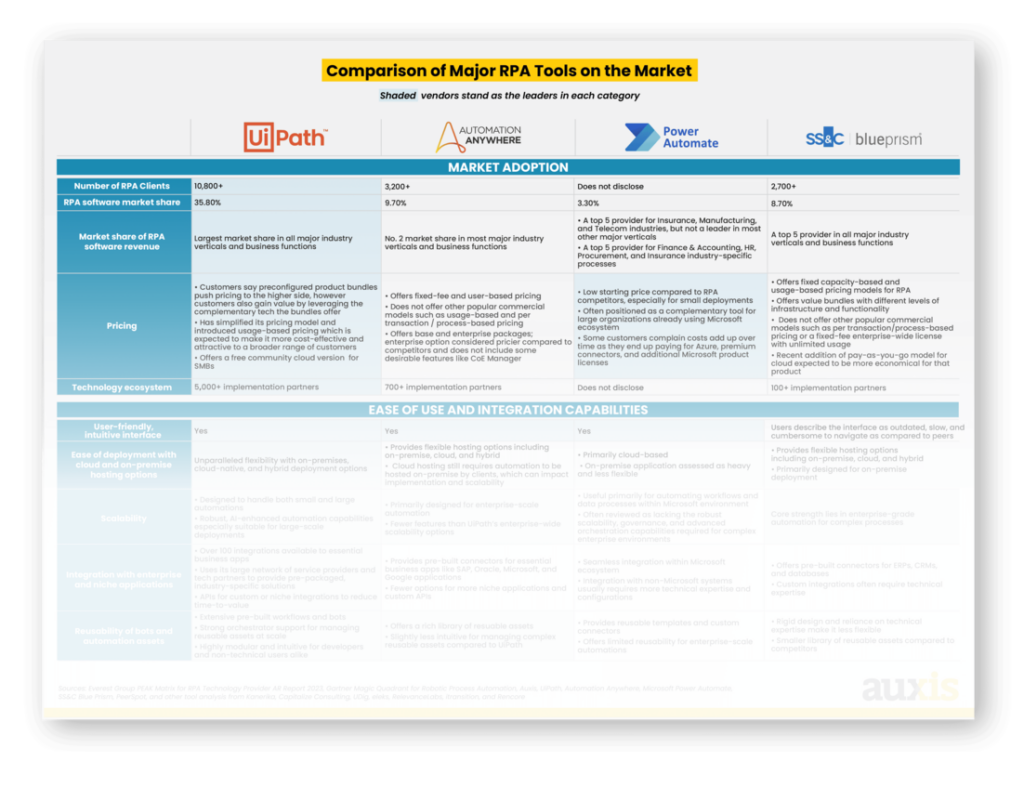
The Evolution of RPA
Generative AI enables significant enhancement of RPA and other automation technologies such as Intelligent Document Processing (IDP), dramatically improving their outcomes. This is possible because Generative AI removes several restrictions that automated systems have had to work with till now; for example, RPA’s need for well-defined rules, requiring developers to fix broken bots, etc.
Agentic automation, on the other hand, leverages agentic AI – software “agents” powered by Generative AI and other advanced AI capabilities – to take autonomous action. The biggest value of agentic automation lies in its potential to efficiently tackle the long chain of activities which make up the complex and differentiated business processes across industries.
RPA works in tandem with these AI advancements to optimize processes from start to finish: robots for automating rules-based tasks, while AI agents complete complex business processes that were previously beyond the reach of automation due to agents’ unprecedented ability now to act independently, adapt to changes, and make informed decisions.
These innovations not only change the way employees work – they change the very work they can do. Businesses are utilizing automation to save money, increase staff productivity, create a better work environment, and attract and retain quality employees to combat painful inflation and labor shortage.
Forward-thinking CIOs use RPA-infused automation to hit company goals better, faster, and smarter. They wield automation as a core tool in their arsenal that not only delivers its own benefits but can enhance other important initiatives like cloud, cybersecurity, business intelligence, data integrity, and integrations.
RPA remains the fastest-growing software segment: Gartner said the global RPA market grew 22 percent to $3.2 billion in 2023 and is projected to grow in double digits for the foreseeable future, expanding at a whopping CAGR of 38.2% to approach $31 billion by 2030.
What are the top RPA tools in the market?
Everest Group’s Robotics Process Automation Products PEAK Matrix Assessment 2024 classifies leading RPA providers as below:
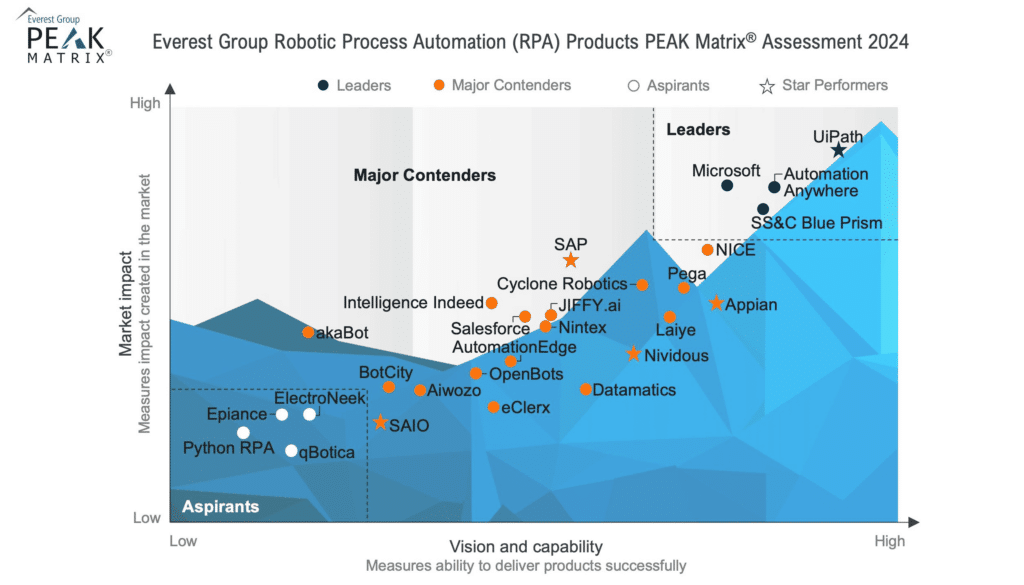
As shown in the figure above, Everest groups RPA providers into three main buckets based on market impact and ability to deliver products successfully.
The latest Everest assessment highlights UiPath as a Star Performer for achieving the greatest year-over-year (YoY) growth. Besides receiving recognition as a Star Performer, the market-leading UiPath platform reinforced its ranking as a Leader for the eighth consecutive year – once again claiming the top spot.
Notably, Microsoft, which had been the only other Star Performer besides UiPath last year, didn’t achieve the rating this time round, while UiPath’s closest pure play competitor – Automation Anywhere – wasn’t included as a Star Performer for the third straight year.
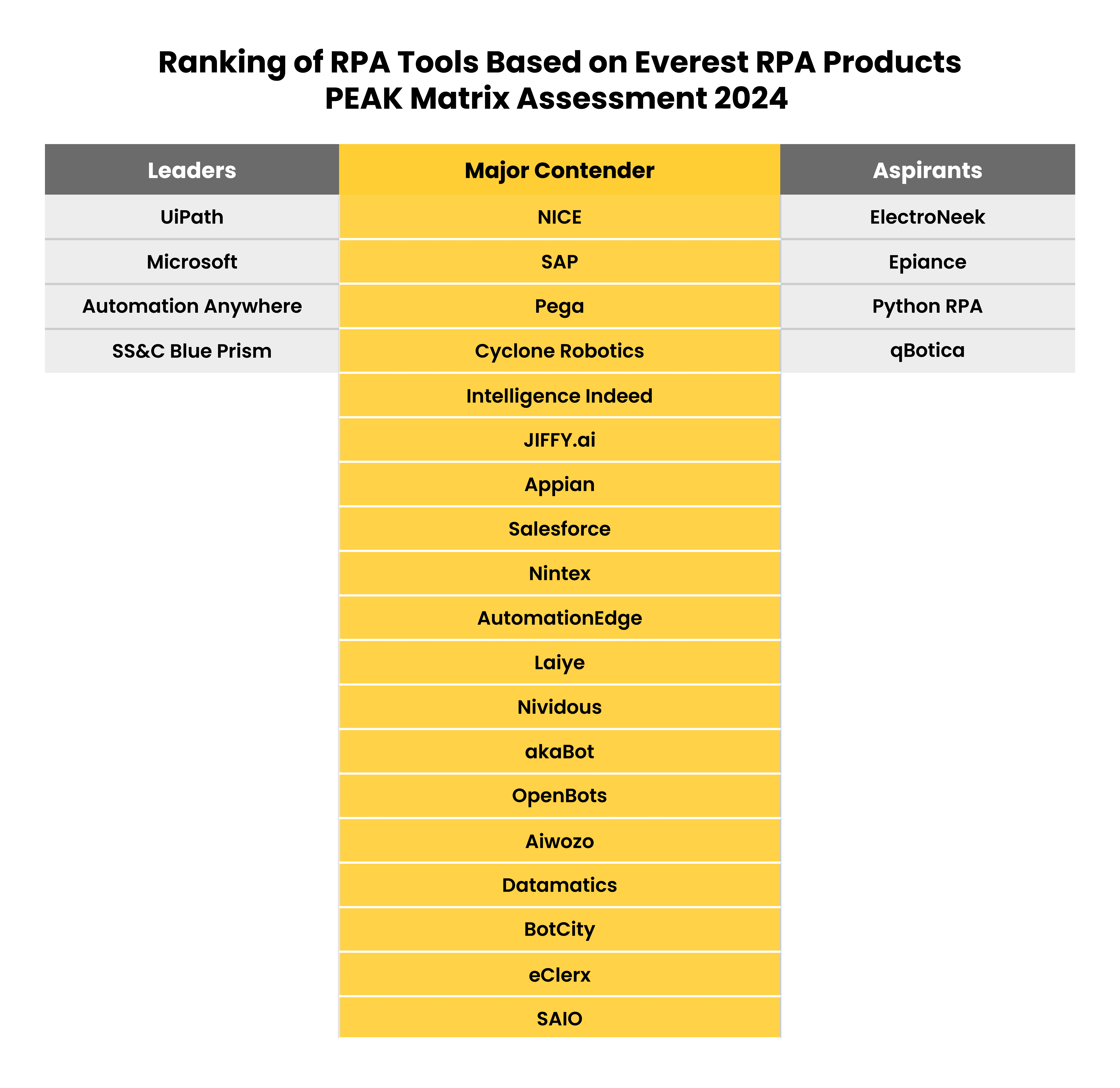
In Gartner’s 2024 Magic Quadrant for RPA as well, UiPath ranks as the #1 RPA platform – for the fifth time in a row – followed by Automation Anywhere. In the last couple of years, Microsoft has gained ground over SS&C Blue Prism, and has emerged as a leader on multiple rankings from leading research firms.
Below we compare the top RPA tools and provide perspective on why UiPath gives you the most “bot for your buck.”
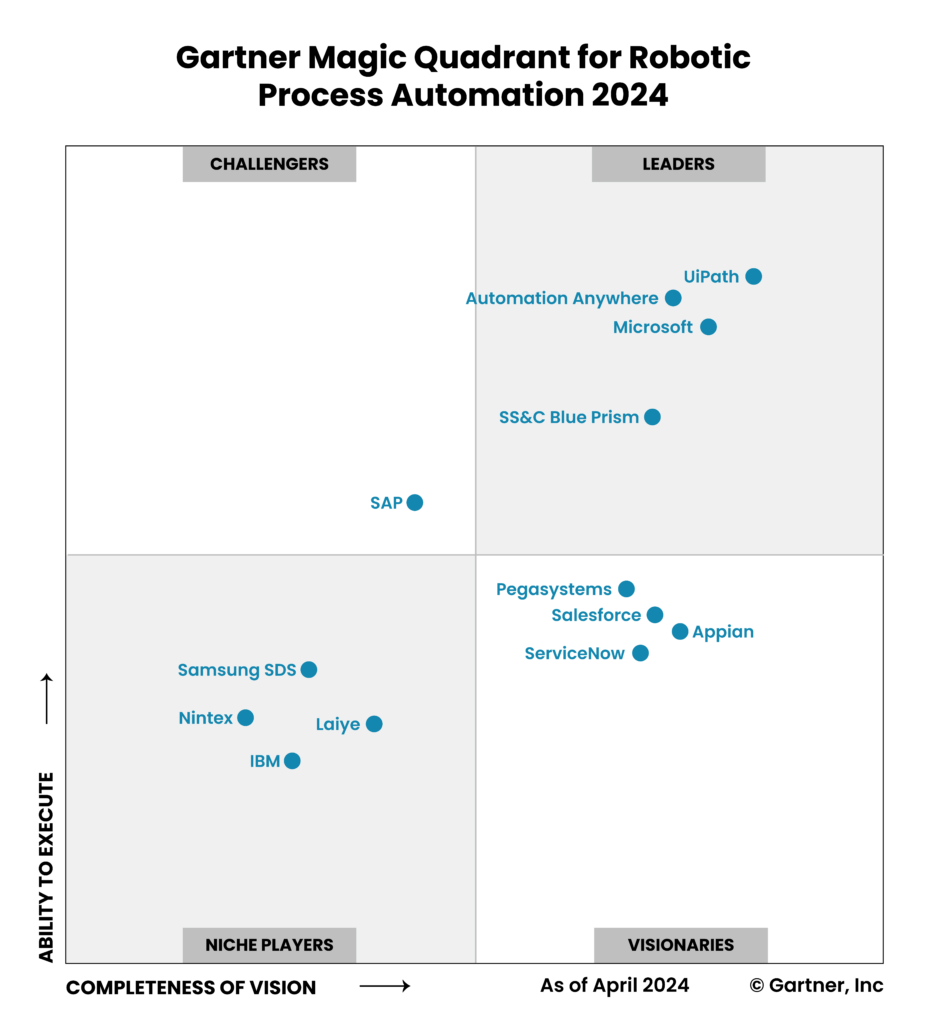
UiPath vs Other RPA Tools
Founded in 2001, Blue Prism is credited with coining the term “Robotic Process Automation.” In 2022, the RPA pioneer rebranded as SS&C Blue Prism after SS&C Technologies Holdings acquired it for $1.6 billion.
Founded in 2003 as Tethys Solutions, Automation Anywhere rebranded to its current name in 2010.
UiPath also began operations under another moniker, DeskOver, in 2005 under CEO Daniel Dines. Ten years later, UiPath was officially born and rebranded as an RPA company.
NICE, which was founded in 1986, started off specializing in contact center technology but today focuses on building AI and automation-powered customer experience software.
Microsoft is a relatively late entrant to the RPA market, as it started offering its RPA solution in 2020 as a built-in capability of its Power Automate platform. It also acquired RPA provider Softmotive in the same year.
The table below provides a quick snapshot of popular RPA tools:
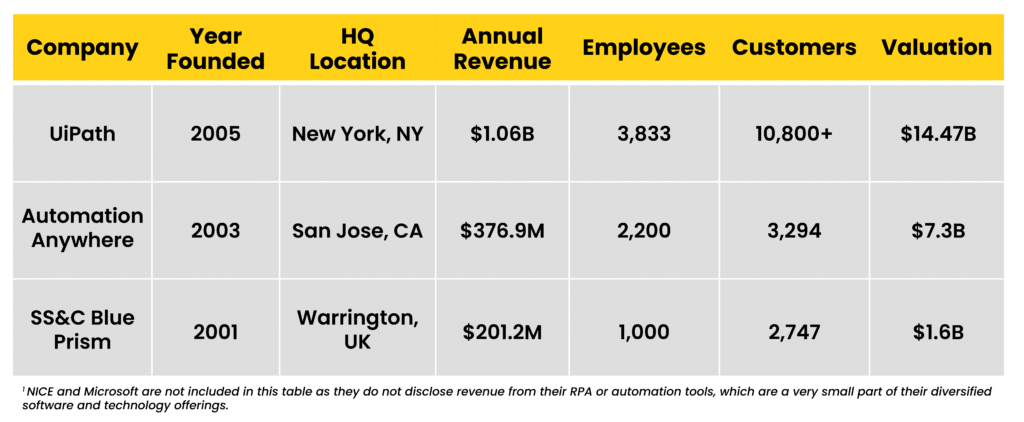
Blue Prism’s longer trajectory initially made it the go-to RPA solution. Most of its clients were large banking and financial institutions – among the only organizations that could afford the technology’s initial high cost of entry then.
Years later, more affordable competitors like UiPath and Automation Anywhere came to market with the same (or better) capabilities and increased flexibility and ease of implementation. As a result, RPA was “democratized” for companies of all sizes across many industries, including small and mid-market organizations.
Today, UiPath and Automation Anywhere have significantly higher revenue streams than Blue Prism, which became a private entity after being acquired by SS&C, shortly after facing a shareholder revolt and criticism over a perceived lack of investment in future products.
Despite Microsoft’s late entry into the RPA market, it’s not surprising that the software giant now ranks as a RPA leader in Everest and Gartner’s rankings. Offering its RPA tool as a part of its Power Automate platform, which has 500,000 customers, has accelerated the tool’s adoption, keeping customers within the Microsoft ecosystem. Microsoft also offers discounts on Power Automate to its Microsoft 365 Enterprise license buyers, thus reducing the cost of RPA acquisition for their customers.
NICE also focuses more on large enterprise customers, with over 80% of its revenue coming from this market segment, as well as on front-office use cases in contact centers and industry-specific processes. This excludes mid-size and small businesses looking to automate repetitive tasks and backend processes, which constitute a significant share of the RPA market.
Another interesting source for RPA tools comparisons is G2, which ranks software and services based on real-time data from verified user reviews. As of 11/12/24, the top RPA platforms rated as follows:
- UiPath: 4.6/5 with 6,660 reviews
- Automation Anywhere: 4.5/5 with 5,490 reviews
- SS&C Blue Prism: 4.5/5 with 398 reviews
- Microsoft Power Automate: 4.5/5 with 469 reviews
To read a G2 comparison of UiPath vs. Automation Anywhere, click here; for UiPath vs. Blue Prism, click here.
What makes UiPath the top-rated RPA tool?
UiPath’s popularity is easy to measure. It is rated as the best RPA software for small, mid-market as well as enterprise businesses on G2.
It is by far the largest vendor in terms of RPA-specific revenue, serving more than 10,000 customers across industries. UiPath is the only pureplay automation provider with over 5,000 RPA clients, a fact which by itself demonstrates its popularity.
The company demonstrates an exceptional ability to retain customers and increase their spending over time, reporting an impressive 121% dollar-based net retention rate. UiPath’s revenue has consistently registered above-market average growth over a relatively larger base, with the company continuing to grow market share.
Some of its biggest strengths, as mentioned by users, are the user-friendly interface, ease of setup and implementation, robust customer support, and the platform’s ability to streamline automation processes and enhance efficiency.
On Everest’s assessment matrix, UiPath rates the highest in market adoption, portfolio mix, vision and strategy, deployment and maintenance as well as product training and support. It also has the highest market share in most industry verticals and across geographies.
Everest highlights the below as having helped UiPath strengthen its Leadership position in its latest assessment:
- UiPath’s integration with generative AI pioneer OpenAI and GPT to enable generative AI-powered features such as after-call summary based on transcripts
- Investment in continuous discovery and strengthened integration of RPA with process mining, task mining, and communications mining
- The enhanced UiPath Integration Services, which enables users to design and share custom API integrations, in addition to the pre-built connectors.
- UiPath’s pre-packaged, industry-specific RPA solutions that reduce time-to-value for customers, as well as its heavy focus on customer training, success, and support.
Gartner also emphasizes UiPath’s product strategy of being uniquely focused on using GenAI to enhance its RPA product and providing its customers with a strong platform for AI-augmented automation development, making it a compelling option for customers. With more than 10,000 enterprise customers and 6,000 systems integrator partners, UiPath offers the largest RPA-specific ecosystem of any vendor. Its enterprise-grade RPA solution continues to increase its dominant market share each year.
Clients also specifically appreciate UiPath’s vision for intelligent automation, rich governance features, and overall product suite.

Key Advantages Offered by UiPath RPA
- Built to support the full automation lifecycle from discovery to measurement. Expanding beyond RPA capabilities, UiPath now offers tools like app development, intelligent document processing, communications mining, process mining, test automation, cloud delivery, embedded analytics, enhanced AI fabric components, a citizen developer-friendly user experience, and API integration.
- UiPath offers a free community edition of its cloud platform specifically for SMBs, helping them get started with automation and creating production-ready RPA robots, without requiring significant upfront investments. None of the other RPA leaders has anything similar to this, making UiPath’s solution uniquely attractive to smaller businesses.
- Free, self-paced, instructor-led training in a variety of languages that are tailored to different personas like professional developers, citizen developers, and business analysts. It also fosters a large online community of users for collaboration and knowledge sharing.
- UiPath delivers the best combination of attended and unattended automation that many customers desire, unlike others like NICE which is designed primarily for attended automation. The latter’s unattended automation methods can be difficult to find and configure, with more technical skills required for server installation and deployment.
- UiPath is also available both as a SaaS solution as well as on-premise, while Microsoft’s solution supports RPA orchestration only in cloud.
- UiPath’s industry-leading enterprise automation platform now includes Generative AI constructed on large foundational models, and Specialized AI built for specific business tasks. These provide robust, scalable, trustworthy, and customized solutions for automating business processes based on clients’ specific business needs.
- UiPath enables agentic orchestration, dubbed the next stage of enterprise automation, which involves automation, AI agents, AI models, and humans working together for better productivity and business outcomes. UiPath provides the perfect orchestration framework, integrating with a variety of enterprise technologies to coordinate actions across disparate systems without being limited by specific tools or environments. Agents benefit from the governance and control the platform provides, precision-oriented robots that execute processes with high reliability, and human-in-the-loop (HITL) capabilities for critical decisions.
- UiPath also announced the availability of Autopilot for everyone: an AI companion that blends the best of Generative AI and Specialized AI. It works across multiple systems and documents for discovering and running existing automations within the enterprise, stringing automations together to accomplish advanced actions, and even creating AI-powered automations by itself.
This makes it possible for Autopilot to carry out a range of tasks independently from end to end, such as submitting an expense report, invoice processing, finding new sales leads, onboarding new hires, etc. - The provider embedding Generative AI into its RPA technology brings us one step closer to self-healing automations, and exponentially increases the value of RPA solutions. With this, a stuck or failed bot could potentially detect issues and take steps to “heal” itself, freeing up developers to focus on more complex tasks and strategic work.
- Another noticeable enhancement is the creation of unattended automations by streamlining the steps needed, helping to scale up and reduce the complexity of setting up unattended automations.
Scaling Automation: the biggest battle to win
Helping clients successfully scale their RPA programs remains an important focus for software vendors and implementation partners. It’s no secret that most organizations still report issues growing their automation initiatives to the level they desire in terms of speed and ROI.
RPA and automation can be game-changing for any organization – when done right. Choosing the best RPA platform, along with the right implementation partner, is instrumental for ensuring automation success for your business. As a top 2% UiPath Partner in the U.S and the 2024 UiPath Foundational Americas Partner of the Year, Auxis brings a proven track record of AI and automation success. Our unique nearshore delivery model differentiates us from other automation providers – overcoming the challenges of Asia-based solutions through nearshore advantages like cost-effectiveness, real-time collaboration, and a deep pool of highly skilled, UiPath-certified AI and automation talent located in Latin America’s top tech markets.
As revolutionary advancements like GenAI and agentic automation bring the potential to fundamentally reshape the future of work via automation, implementing UiPath with Auxis can be the right choice to help you make that potential a reality.
To schedule a consultation on how Auxis can support you in your RPA journey, click here. To read more about Auxis’ UiPath capabilities and some of Auxis’ RPA client case studies, click here.




